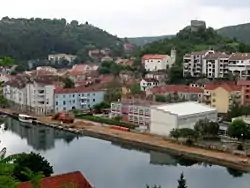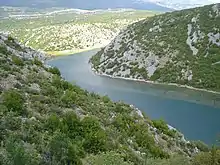Obrovac, Croatia
Obrovac (pronounced [ɔbrɔ̌ːʋats]; Italian: Obrovazzo) is a town located in northern Dalmatia, in the Zadar County of Croatia. The Obrovac municipality has a total population of 4,323 people. The town is located in the canyon of the river Zrmanja.
Obrovac | |
|---|---|
| Grad Obrovac Town of Obrovac | |
 View of Obrovac | |
 Obrovac Location of Obrovac in Croatia | |
| Coordinates: 44.20053°N 15.68143°E | |
| Country | |
| County | |
| Government | |
| • Mayor | Ante Župan (HDZ) |
| Area | |
| • Town | 353.0 km2 (136.3 sq mi) |
| • Urban | 1.2 km2 (0.5 sq mi) |
| Population (2021)[2] | |
| • Town | 3,453 |
| • Density | 9.8/km2 (25/sq mi) |
| • Urban | 793 |
| • Urban density | 660/km2 (1,700/sq mi) |
| Time zone | UTC+1 (Central European Time) |
| Website | obrovac |
Geography

Obrovac is a town on the Zrmanja River some 11 km from the mouth of the river of the Novigrad sea. Above the town are the ruins of a fortified city. Its tributary Krupa attracts numerous day-trippers, and in recent times, rafting, canoe, and kayak lovers. Not far from the town of Krupa is a monastery with a valuable icon collection. About 2 km (1.24 mi) north-west of the town, along the road heading up to the mountains, lies a huge deserted industrial complex, an alumina plant built in the 1970s. South of the town there is extraordinary Bijela River canyon with a lot of waterfalls and small ponds and pools.
History

Obrovac first got its name in 1337. In 1527 Obrovac was taken over by the Ottoman Turks.
In October 1683, the population of Venetian Dalmatia, principally Uskoks of Ravni kotari, took arms and together with the rayah (lower class) of the Ottoman frontier regions rose up, taking Skradin, Karin, Vrana, Benkovac and Obrovac.[3] In 1687, Stojan Janković, a Morlach leader, forced the Ottomans out of Obrovac.
In 2008, Obrovac unveiled a restored riviera, which was the biggest financial investment in the city since Croatian independence.[4] In 2009, a mass grave from World War II was found in the area.[5]
Demographics
The total population is 4,323, distributed in the following settlements:[6]
- Bilišane, population 176
- Bogatnik, population 131
- Golubić, population 132
- Gornji Karin, population 1,125
- Kaštel Žegarski, population 135
- Komazeci, population 42
- Krupa, population 127
- Kruševo, population 1,112
- Muškovci, population 100
- Nadvoda, population 170
- Obrovac, population 996
- Zelengrad, population 77
The municipality's population peaked at 13,498 in the 1971 census.[7] In the 1970s and 1980s, due to a low living standard in the area, Obrovac was significantly affected by emigration.[8]
According to the 1991 census, shortly before the start of the Croatian War of Independence, 65.5% of population declared as ethnic Serbs.[9] During Operation Storm, a large portion of the town population evacuated the area before the Croatian Army entered the town on 5 August 1995, the second day of the operation.[10] The current majority are Croats with 65.7%, while 31.4% are Serbs.[11]
| population | 6186 | 6814 | 7207 | 7408 | 8751 | 9814 | 9027 | 10092 | 9116 | 9696 | 10185 | 10321 | 9576 | 9069 | 3387 | 4323 | 3453 |
| 1857 | 1869 | 1880 | 1890 | 1900 | 1910 | 1921 | 1931 | 1948 | 1953 | 1961 | 1971 | 1981 | 1991 | 2001 | 2011 | 2021 |
Politics
Minority councils and representatives
Directly elected minority councils and representatives are tasked with consulting tasks for the local or regional authorities in which they are advocating for minority rights and interests, integration into public life and participation in the management of local affairs.[12] At the 2023 Croatian national minorities councils and representatives elections Serbs of Croatia fulfilled legal requirements to elect 15 members minority councils of the Town of Obrovac.[13]
People from Obrovac
- Janko Mitrović (1613–1659), Morlach army leader
- Stojan Janković (1636–1687), Morlach army leader
- Simeon Končarević (1690–1769), Serbian Orthodox bishop of Dalmatia and Albania
- Gerasim Zelić (1752–1828), Serbian Orthodox archimandrite and writer
- Dado Pršo's family
- Milan Pršo
- Arijan Komazec
- Obrad Zelić
- Aleksandar Veselinović
References
- Register of spatial units of the State Geodetic Administration of the Republic of Croatia. Wikidata Q119585703.
- "Population by Age and Sex, by Settlements, 2021 Census". Census of Population, Households and Dwellings in 2021. Zagreb: Croatian Bureau of Statistics. 2022.
- Radovan Samardžić (1990). Seobe srpskog naroda od XIV do XX veka: zbornik radova posvećen tristagodišnjici velike seobe Srba. Zavod za udžbenike i nastavna sredstva. ISBN 9788617015631.
Становништво Млетачке Далмације, на првом месту Котарски ускоци, још у октобру 1683. дигло се на оружје заједно с рајом у пограничним крајевима Турске. Устаници су "сами заузели Скрадин, Карин, Врану, Бенковац и Обровац
- Kalmeta u Obrovcu otvorio obnovljenu rivu
- Stratišta iz Drugog svjetskog rata: tajne zakopane 60 godina, Slobodna Dalmacija
- "Population by Age and Sex, by Settlements, 2011 Census: Obrovac". Census of Population, Households and Dwellings 2011. Zagreb: Croatian Bureau of Statistics. December 2012.
- Graovac & Glamuzina 2002, p. 86.
- Graovac & Glamuzina 2002, p. 87.
- Graovac & Glamuzina 2002, p. 93.
- "Donosimo detalje akcije Oluja – tako se oslobađala domovina!". Večernji list (in Croatian). 4 August 2013. Retrieved 26 March 2015.
- "Population by Ethnicity, by Towns/Municipalities, 2011 Census: County of Zadar". Census of Population, Households and Dwellings 2011. Zagreb: Croatian Bureau of Statistics. December 2012.
- "Manjinski izbori prve nedjelje u svibnju, kreću i edukacije". T-portal. 13 March 2023. Retrieved 10 June 2023.
- "Informacija o konačnim rezultatima izbora članova vijeća i izbora predstavnika nacionalnih manjina 2023. XIII. ZADARSKA ŽUPANIJA" (PDF) (in Croatian). Državno izborno povjerenstvo Republike Hrvatske. 2023. p. 7. Retrieved 13 June 2023.
Sources
- Graovac, Vera; Glamuzina, Martin (June 2002). "Contemporary Dynamics and Population Structures of former Obrovac District" (PDF). Geoadria. 7 (1): 83–96. doi:10.15291/geoadria.80. Retrieved 3 May 2017.
Further reading
- Conago, Josip (September 1928). "Sredovječne kule i gradine oko Novigrada i Karina" (PDF). Starohrvatska Prosvjeta (in Croatian). II (1–2): 127–135. Retrieved 26 March 2015.
